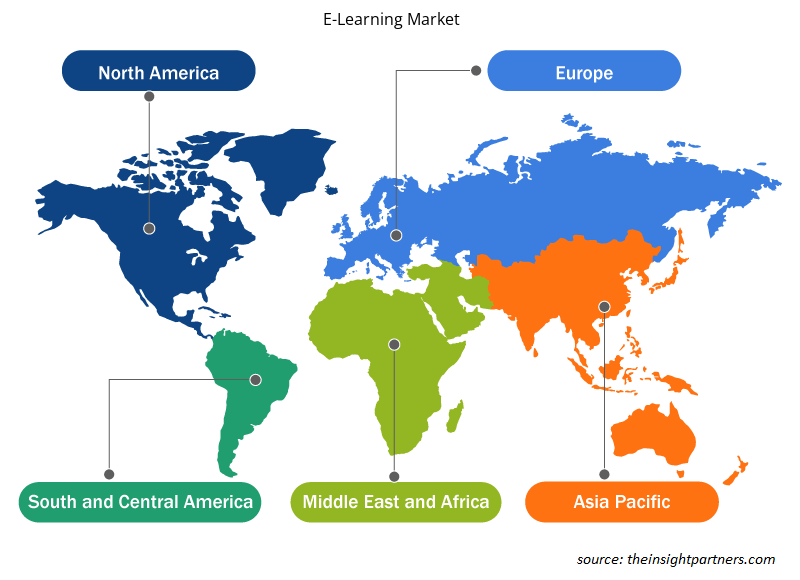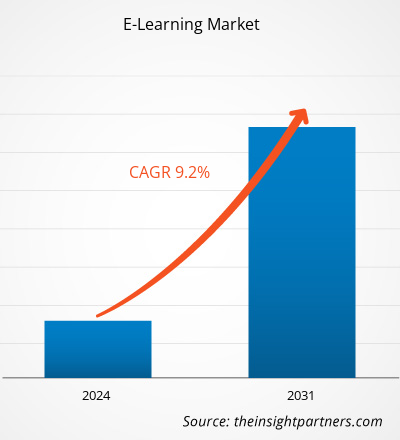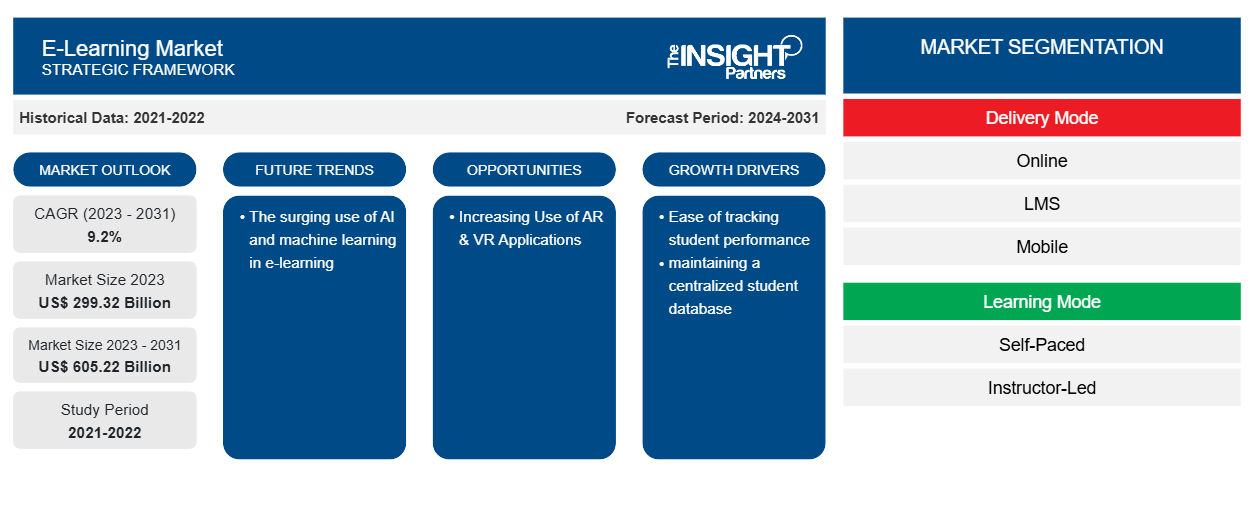Si prevede che il mercato dell'e-learning raggiungerà i 605,22 miliardi di dollari entro il 2031, rispetto ai 299,32 miliardi di dollari del 2023.Si prevede che il mercato registrerà un CAGR del 9,2% nel periodo 2023-2031. È probabile che l'uso crescente dell'intelligenza artificiale e dell'apprendimento automatico nell'e-learning rimanga una tendenza chiave nel mercato.
Analisi di mercato dell'e-learning
L'istruzione online e basata sulla tecnologia ha superato l'istruzione in aula in termini di costi, accessibilità, tempo e praticità. Gli studenti possono migliorare le proprie competenze iscrivendosi a corsi forniti dai migliori esperti e università in tutto il mondo. Oltre agli studenti, i professionisti sono un altro importante segmento target per le organizzazioni di apprendimento digitale. Le certificazioni online sono diventate sempre più popolari nell'attuale clima aziendale competitivo. L'aggiornamento continuo delle competenze è previsto in vari settori, tra cui IT, BPO, KPO e start-up. Il personale aziendale sta sempre più seguendo corsi online per rimanere al passo con i tempi, mentre la maggior parte dei professionisti richiede certificati per il proprio lavoro.
Panoramica del mercato dell'e-learning
Il mercato dell'apprendimento digitale si sta espandendo rapidamente nei paesi in via di sviluppo, con un elevato numero di start-up che si stanno unendo al settore. Il settore dell'apprendimento digitale è guidato da fattori quali l'aumento dell'utilizzo di Internet, i vincoli di tempo, gli ostacoli geografici e i costi ridotti per la formazione online. Questi driver promuovono l'apprendimento autonomo e ne ampliano la portata. Con l'aumento della domanda di certificazione di qualità, sempre più persone si rivolgono a programmi di apprendimento online.
Personalizza questo report in base alle tue esigenze
Riceverai la personalizzazione gratuita di qualsiasi report, comprese parti di questo report, o analisi a livello nazionale, pacchetto dati Excel, oltre a usufruire di grandi offerte e sconti per start-up e università
-
Scopri le principali tendenze di mercato in questo rapporto.Questo campione GRATUITO includerà analisi di dati che spaziano dalle tendenze di mercato alle stime e alle previsioni.
Driver e opportunità del mercato dell'e-learning
Aumento del numero di dispositivi connessi e crescente penetrazione di Internet a favore del mercato
La domanda di dispositivi connessi, come tablet, laptop e smartphone, sta aumentando a livello globale. La domanda è ulteriormente catalizzata dagli scenari di apprendimento da casa e lavoro da casa. Poiché gli studenti non potevano frequentare lezioni scolastiche o di tutoraggio a causa del blocco e delle misure di distanziamento sociale dovute alla pandemia di COVID-19, la loro istruzione è stata condotta online, spingendo alla fine la domanda di smartphone e laptop. Inoltre, lo sviluppo dei servizi di telecomunicazione a livello globale ha portato a un aumento della penetrazione di Internet, anche nelle aree remote del mondo, questo sta integrando il mercato globale dell'e-learning.
Utilizzo crescente di applicazioni AR e VR
Negli ultimi anni, le tecnologie di Realtà Aumentata (AR) e Realtà Virtuale (VR) hanno guadagnato popolarità nei settori dell'istruzione e della formazione come metodi eccellenti per migliorare l'esperienza di apprendimento. AR e VR possono fornire apprendimento remoto e flessibile, consentendo agli studenti di accedere a materiali di formazione e simulazioni da qualsiasi parte del mondo. Ciò può essere particolarmente utile quando gli studenti non sono in grado di partecipare a sessioni di formazione di persona.
Analisi della segmentazione del rapporto di mercato dell'e-learning
I segmenti chiave che hanno contribuito alla derivazione dell'analisi di mercato dell'e-learning sono la modalità di distribuzione, la modalità di apprendimento e l'utente finale.
- In base alla modalità di distribuzione, il mercato dell'E-Learning è suddiviso in online, LMS, mobile e altri. Il segmento online ha detenuto una quota di mercato maggiore nel 2023.
- In base alla modalità di apprendimento, il mercato è segmentato in autonomo e con istruttore.
- In base all'utente finale, il mercato è segmentato in accademico e aziendale. Le istituzioni K-12 e superiori sono i sottosegmenti più importanti del segmento dell'utente finale.
Analisi della quota di mercato dell'e-learning per area geografica
L'ambito geografico del rapporto sul mercato dell'e-learning è suddiviso principalmente in cinque regioni: Nord America, Asia Pacifico, Europa, Medio Oriente e Africa, Sud e Centro America.
Il Nord America ha dominato la quota di mercato dell'e-learning nel 2023. Secondo il rapporto HurixDigital 2023, gli Stati Uniti sono uno dei paesi leader al mondo in termini di implementazione di successo dell'eLearning nell'istruzione.
Approfondimenti regionali sul mercato dell'e-learning
Le tendenze regionali e i fattori che influenzano il mercato dell'e-learning durante il periodo di previsione sono stati ampiamente spiegati dagli analisti di Insight Partners. Questa sezione discute anche i segmenti e la geografia del mercato dell'e-learning in Nord America, Europa, Asia Pacifico, Medio Oriente e Africa e America meridionale e centrale.

- Ottieni i dati specifici regionali per il mercato dell'e-learning
Ambito del rapporto sul mercato dell'e-learning
| Attributo del report | Dettagli |
|---|---|
| Dimensioni del mercato nel 2023 | 299,32 miliardi di dollari USA |
| Dimensioni del mercato entro il 2031 | 605,22 miliardi di dollari USA |
| CAGR globale (2023-2031) | 9,2% |
| Dati storici | 2021-2022 |
| Periodo di previsione | 2024-2031 |
| Segmenti coperti |
Per modalità di consegna
|
| Regioni e Paesi coperti |
America del Nord
|
| Leader di mercato e profili aziendali chiave |
|
Densità degli attori del mercato dell'e-learning: comprendere il suo impatto sulle dinamiche aziendali
Il mercato dell'E-Learning sta crescendo rapidamente, spinto dalla crescente domanda degli utenti finali dovuta a fattori quali l'evoluzione delle preferenze dei consumatori, i progressi tecnologici e una maggiore consapevolezza dei vantaggi del prodotto. Con l'aumento della domanda, le aziende stanno ampliando le loro offerte, innovando per soddisfare le esigenze dei consumatori e capitalizzando sulle tendenze emergenti, il che alimenta ulteriormente la crescita del mercato.
La densità degli operatori di mercato si riferisce alla distribuzione di aziende o società che operano in un particolare mercato o settore. Indica quanti concorrenti (operatori di mercato) sono presenti in un dato spazio di mercato in relazione alle sue dimensioni o al valore di mercato totale.
Le principali aziende che operano nel mercato dell'E-Learning sono:
- Corsia
- edX
- Apprendimento tramite LinkedIn
- Condivisione delle competenze
- Abilitàsoft
- Udacità
Disclaimer : le aziende elencate sopra non sono classificate secondo un ordine particolare.

- Ottieni una panoramica dei principali attori del mercato dell'e-learning
Notizie e sviluppi recenti del mercato dell'e-learning
Il mercato dell'E-Learning viene valutato raccogliendo dati qualitativi e quantitativi post-ricerca primaria e secondaria, che includono importanti pubblicazioni aziendali, dati associativi e database. Di seguito sono elencati alcuni degli sviluppi nel mercato dell'E-Learning:
- William Woods University WWU) ha annunciato oggi ufficialmente un accordo con Coursera, una piattaforma di apprendimento online globale, che amplierà significativamente l'accesso ai contenuti digitali pertinenti al mondo del lavoro odierno, offrendo formazione sulle competenze e certificazioni riconosciute dal settore di competenze lavorative richieste a studenti, personale, ex studenti e partner universitari della WWU. La nuova partnership consentirà alla William Woods di imparare da oltre 325 università e aziende di alto livello su Coursera, con corsi online e credenziali in una varietà di discipline e di inserirle nel curriculum dell'università, migliorando ulteriormente l'esperienza accademica e la commerciabilità occupazionale di ogni studente della WWU. (Fonte: William Woods University, comunicato stampa, febbraio 2024)
- edX e Degreed hanno annunciato una partnership strategica ampliata per fornire alle organizzazioni contenuti educativi di prima qualità e soluzioni di piattaforma che promuovano l'apprendimento basato sulle competenze. Ora, edX For Business, una soluzione di contenuti best-in-class per le organizzazioni che cercano di promuovere programmi di apprendimento e sviluppo più efficaci, è disponibile per le organizzazioni e i loro dipendenti direttamente all'interno della piattaforma Degreed, riflettendo uno sforzo concertato per ridefinire il modo in cui le aziende formano, migliorano le competenze e mantengono i talenti a ogni livello della loro forza lavoro. (Fonte: edX, comunicato stampa, dicembre 2023)
Copertura e risultati del rapporto sul mercato dell'e-learning
Il rapporto “Dimensioni e previsioni del mercato dell’e-learning (2021-2031)” fornisce un’analisi dettagliata del mercato che copre le seguenti aree:
- Dimensioni e previsioni del mercato dell'e-learning a livello globale, regionale e nazionale per tutti i segmenti di mercato chiave coperti dall'ambito
- Tendenze del mercato dell'e-learning e dinamiche di mercato come driver, vincoli e opportunità chiave
- Analisi dettagliata delle cinque forze PEST/Porter e SWOT
- Analisi del mercato dell'e-learning che copre le principali tendenze del mercato, il quadro globale e regionale, i principali attori, le normative e i recenti sviluppi del mercato
- Analisi del panorama industriale e della concorrenza che copre la concentrazione del mercato, l'analisi della mappa di calore, i principali attori e gli sviluppi recenti per il mercato dell'e-learning
- Profili aziendali dettagliati
- Analisi storica (2 anni), anno base, previsione (7 anni) con CAGR
- Analisi PEST e SWOT
- Valore/volume delle dimensioni del mercato - Globale, Regionale, Nazionale
- Industria e panorama competitivo
- Set di dati Excel
Report recenti
Testimonianze
Motivo dell'acquisto
- Processo decisionale informato
- Comprensione delle dinamiche di mercato
- Analisi competitiva
- Analisi dei clienti
- Previsioni di mercato
- Mitigazione del rischio
- Pianificazione strategica
- Giustificazione degli investimenti
- Identificazione dei mercati emergenti
- Miglioramento delle strategie di marketing
- Aumento dell'efficienza operativa
- Allineamento alle tendenze normative























 Ottieni un campione gratuito per - Mercato dell'e-learning
Ottieni un campione gratuito per - Mercato dell'e-learning